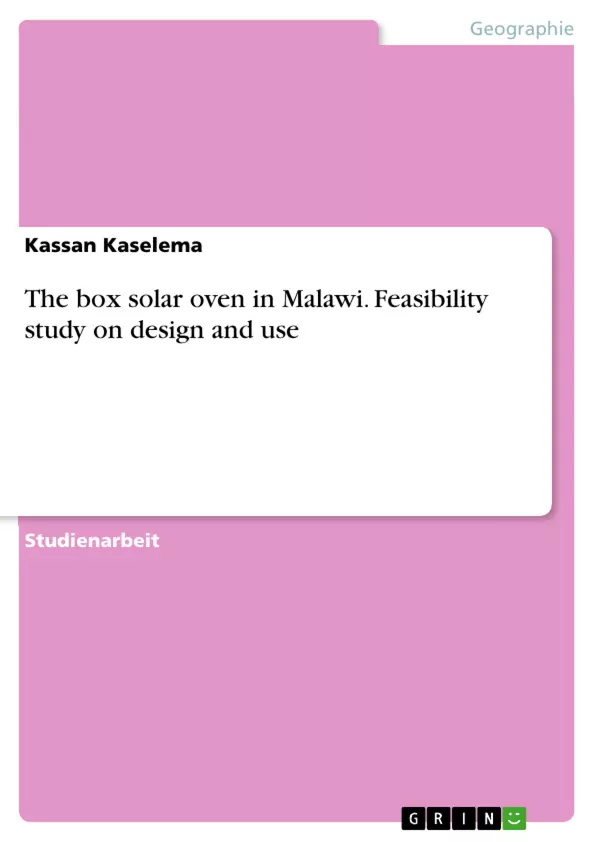This paper is a feasibility study on design and use of the solar oven in Malawi. The inexorable need to cook food for nourishment is fundamental to nearly every society and there is an upsurge requirement of the expenditure of energy in some form due to an increase in human population. These form of energy include solar energy technology. It can be harnessed to meet the energy need for food preparation without the environmental and health problems associated with biomass fuels mostly used by Malawians. For period immemorial, societies have been using solar energy directly or indirectly to dehydrate, warm, and dry different food items.
This brings into confusion as to why there is little acceptability by the communities in using solar devices. There are a wide variety of devices designed to capture the sun’s energy and harness it for different purposes and includes solar heater , solar cooker, solar dryer, solar still and solar air heating systems. Also peculiar and of concern in this project is the solar oven. Many of the projects that have been carried out around the world with others are still in progress. Among other objectives the preliminary idea in conducting the solar oven project was to determine if they can effectively be used in Malawi. The idea to carry a feasibility study on design and use of the solar oven was initiated since by the time of carrying this project, no published literature about box type solar oven projects in Malawi was available. It was discovered that other countries have societies pertaining to solar cooking technology despite the effort by the Illinois, USA company in distributing solar ovens in Malawi.
This causes wonders as to why Malawi was not embarking on solar oven project as research about insolation levels about the country had shown to be effective enough for solar cooking. There are three types of solar ovens currently in use globally and literature review showed that there is clear room for improvement. The research focused much on box type of solar oven and a new type was designed to address some of the perceived weaknesses and determine if ever it can be applied in Malawi. This new solar oven incorporates a number of strategies drawn from thermal performance of the solar ovens and cookers, which were normalized with a set of standard environmental conditions. Observations based on ergonomics and safety were also given consideration in designing the oven in this scenario.
Inhaltsverzeichnis
-
- INTRODUCTION AND OBJECTIVES
- Introduction
- Status of Biomass Utilization in Malawi
- INNOVATED SOLAR BOX OVEN
- THE STRATEGY BEHIND THE OVEN PROJECT
- PROJECT OBJECTIVES
- GENERAL OBJECTIVE
- SPECIFIC OBJECTIVES
- LITERATURE REVIEW
- PRINCIPLES IN OVEN OPERATION
- ENERGY ENVIRONMENTAL POLICY IN MALAWI
- MATERIALS AND METHODS
- DESIGN
- RESULTS AND DISCUSSION
- Conversion Efficiency
- Rate of Energy Released by the oven
- The standard stagnation temperature
- standard sensible heating time
- DISCUSSION
- IMPACTS
- CONCLUSIONS AND RECOMMENDATIONS
- CONCLUSIONS
- RECOMMENDATION
Zielsetzung und Themenschwerpunkte
Dieses Projektbericht befasst sich mit der Machbarkeitsstudie zum Entwurf und Einsatz eines Solarofens, wobei der Fokus auf die Anpassung des Designs liegt, um seine Eignung für die lokalen Bedingungen in Malawi zu bewerten. Das Projekt zielt darauf ab, die Effizienz des Solarofens unter den spezifischen meteorologischen Bedingungen Malawis zu untersuchen und Verbesserungsvorschläge für das Design zu erarbeiten, um seine Praktikabilität und seinen Nutzen für die lokale Bevölkerung zu maximieren.
- Bewertung der Leistung des Solarofens in Malawi
- Optimierung des Solarofendesigns für lokale Bedingungen
- Bewertung des Einflusses von meteorologischen Faktoren auf die Ofeneffizienz
- Identifizierung von Herausforderungen und Entwicklung von Empfehlungen für zukünftige Projekte
- Beitrag zur nachhaltigen Energieversorgung in Malawi
Zusammenfassung der Kapitel
- Kapitel 1 bietet eine Einführung in das Projekt und die Ziele. Es behandelt den aktuellen Stand der Biomasse-Nutzung in Malawi und stellt das neuartige Solarofen-Design sowie die dahinterstehende Strategie vor. Die Kapitelziele werden im Detail erläutert, wobei ein allgemeines Ziel und spezifische Ziele definiert werden.
- Kapitel 2 beleuchtet den theoretischen Hintergrund, indem die Prinzipien des Ofenbetriebs und die Energie- und Umweltpolitik in Malawi beleuchtet werden.
- Kapitel 3 geht auf die Materialien und Methoden ein, die für den Bau und die Durchführung des Experiments verwendet werden. Es gibt einen detaillierten Überblick über das Design des Solarofens.
- Kapitel 4 präsentiert die Ergebnisse und diskutiert die Effizienz des Solarofens. Es werden die Energieumwandlungseffizienz, die vom Ofen freigesetzte Energiemenge, die Standard-Stagnationstemperatur und die Standard-Wärmezeit analysiert.
- Kapitel 5 befasst sich mit den Auswirkungen des Solarofens auf die lokale Bevölkerung und die Umwelt.
Schlüsselwörter
Solarofen, Machbarkeitsstudie, Designoptimierung, meteorologische Bedingungen, Energieumwandlungseffizienz, Biomasse, nachhaltige Energie, Malawi.
- Quote paper
- Kassan Kaselema (Author), 2015, The box solar oven in Malawi. Feasibility study on design and use, Munich, GRIN Verlag, https://www.grin.com/document/1158433



